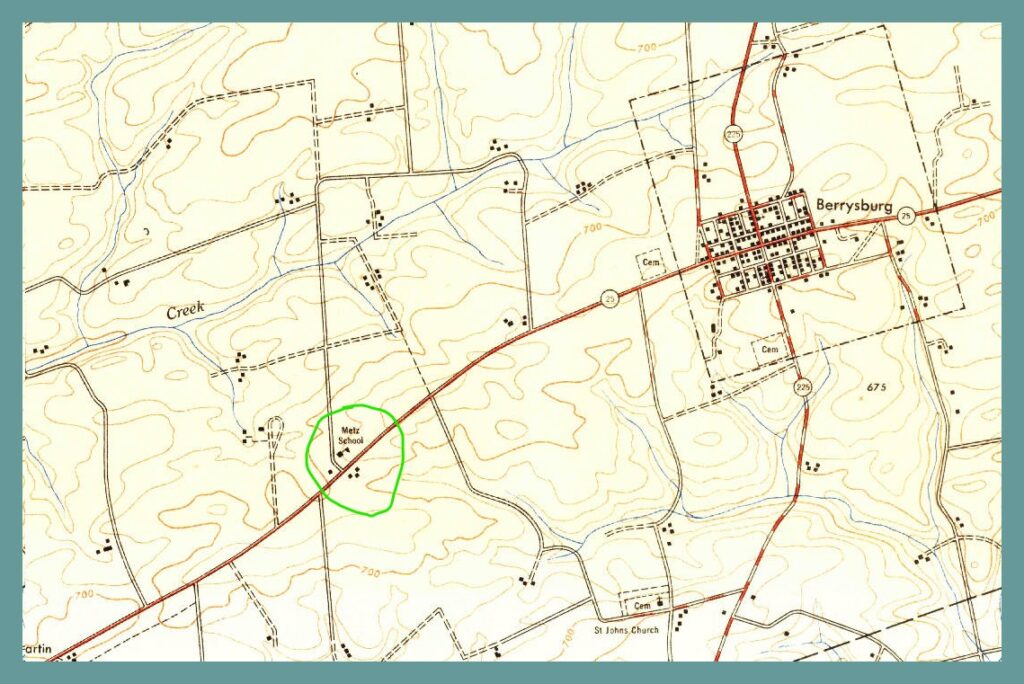A 1947 topographical map (Elizabethville Quadrant) showing the location of the Metz School, west of Berrysburg on the northeast corner of Hoover Road and Route 25, Mifflin Township, Dauphin County, Pennsylvania.
A brief history of this school can be found in the program, “Memories: Metz Country School Reunion,” October 12, 2002, published for the reunion held at the Halifax Area Ambulance Building:
THE METZ SCHOOL
A One Room Country School in Mifflin Township, Dauphin County, Pennsylvania.
Our memories of the Metz School begin with Norwood Hoover relating what he remembers his parents, Mr. and Mrs. Henry F. Hoover, telling him when he was a child.
The Metz school was built on property owned by Charles Metz. The Metz family donated the northeast corner of land along route 25 and Hoover Road (present home of Norwood Hoover). A school was built on the property with the understanding if the school would ever close the land would revert to the original owners of the farm.
The Metz school was closed in 1948 and its pupils were transferred to Berrysburg. Therefore the land reverted to the Metz family heirs (the farm had been purchased by Henry Hoover circa 1919). The two Metz granddaughters were contacted and they signed release forms for the land on which the school was built. The school and its contents were offered up for public sale December 10th, 1948. Mr. Hoover purchased the building and renovations began for a home for his son Norwood.
Description of the School
The northwest corner of the cellar housed the coal bin (this was the only portion of the cellar excavated. Norwood relates a story of getting coal out of the bin for the big round furnace, which was in the southwest corner of the room. This job was always delegated to the larger boys in the school. One day Harry Klinger, the teacher, told him to “fetch” coal out of the cellar. Norwood dutifully opened the trap like door located in the front of the room in the platform. Of course when you went for coal the door was left open until the chore complete (dark down there). in the meantime Mr. Klinger became perturbed about another pupil, backed up and fell down the steps. This scared Norwood who was in the cellar filling the coal bucket so much he had to go home and change into dry pants.
The platform was in the front of the room, the teacher’s desk in the center and at the back of the platform. The blackboard was across the front with the ABC’s hanging above. Maps that could be unrolled also hung above the blackboard.
There was no electricity and the huge furnace was defeated on a windy day. Of course air conditioning would not have been necessary because there was always a good air exchange in this type of building. The old stand with drawers of samples of various grains. Another drawer held cotton, flax, wool, etc., for teaching purposes. The water cooler (the water was never cold except in winter when everything was cold) was on the right as you came into the room. Where did you get the water? The closest neighbor. We would take the bucket, run across the Hoover’s yard to the west side of the house and there was the hand pump, fill it and return. Each of us had our own tin cup and was not allowed to share. Rows of hooks to hang our coats, bandanas and all we wore to hike to school in deepest snows. May times our clothes were still wet when we put them on to return home that evening, and many mornings they were not completely dry when we repeated the day before.
The outhouses! A most necessary part of the school. Metz’s had outhouses built against the south wall of the school. Boys on the right, girls on the left. The school entry door was in the middle. Never took long to GO, as you only had a few steps.
What was a school day like? Morning exercises began at 8:00 a. m. with reading of a scripture passage chosen by the teacher. Here we remember Mr. Charles Harris who was the last teacher to teach at Metz’s (circa 1936-1948). Mr. Harris taught all eight grades, maybe there was only one child in a grade or maybe it was three or four. Each class had spelling and arithmetic in the morning, in addition English, history, geography, reading, or health some other time during the day. Friday afternoon’s were fun times, with spelling bees, arithmetic bees, art and music with Mr. Harris and his pitch pipe or occasionally Mr. Light with his flute. Mr. Harris also monitored a morning and afternoon recess, with a lunch hour at noon. He and he alone was responsible for his students. And then at 3:30 p. m. we would march off to home only to repeat the process the next day.
The teachers within Mifflin Township often transferred from one school to another if in the meantime they moved their family nearer to a different school than they were teaching at the time….
______________________________________________
Digital images of reunion program provided by Jean M. Deppen. Map cut from 1947 Elizabethville Quadrant.
Corrections and additional information should be added as comments to this post.
